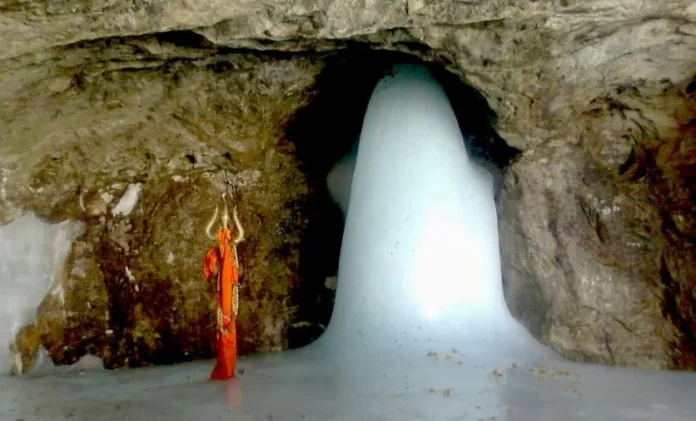The Amarnath Temple is a sacred pilgrimage site in Hinduism. Amarnath Cave (Gufa) is located at an altitude of 3,888 meters (12,756 feet) in the Himalayan region of Jammu and Kashmir. Here we are presenting you 19 rare and interesting facts about the Amarnath Yatra.
The Amarnath Yatra holds great religious significance because the cave of Amarnath houses a naturally formed ice lingam, which is worshipped as Lord Shiva by devotees. The yatra, spanning several weeks, attracts pilgrims from all walks of life.
Facts About Amarnath Yatra

We have compiled many rare and unknown facts about Amarnath Yatra and its Cave (Gufa) so don’t forget to read till the end.
Here are the 19 amazing facts about Amarnath Yatra that will surprise you for sure.
1. Legends and Historical Facts About Amarnath Yatra
The history of the Amarnath Yatra dates back thousands of years and is deeply rooted in Hindu mythology and beliefs.
According to ancient Hindu scriptures, it is said that Lord Shiva, the supreme deity in Hinduism, chose the Amarnath Cave as the place to reveal the secrets of immortality and creation to his consort, Parvati.
Information about Amarnath’s cave is mentioned in ancient Hindu texts, including the Mahabharata and the Rajatarangini. It is believed to have been a place of worship for devotees of Lord Shiva since time immemorial.
Amarnath Cave remained concealed for centuries until it was rediscovered by a Muslim shepherd named Buta Malik in the 15th century. The story goes that Lord Shiva revealed the secret of immortality to Buta Malik inside the cave.
Legend has it that when Malik became aware of the holy cave, he was blessed with a bag of coal that transformed into a bag of gold upon his return.
Recognizing the sanctity of the place, he shared the news with the local Hindu ruler, Sultan Zain-ul-Abidin, who then arranged for the pilgrimage to the cave to commence.
Throughout history, the Amarnath Yatra has witnessed various phases of popularity and decline.
2. Maharaja Gulab Singh Supported the Pilgrimage
Amarnath Yatra gained prominence during the reign of Maharaja Gulab Singh, the founder of the princely state of Jammu and Kashmir in the 19th century, as he supported and facilitated the pilgrimage. Since then, the pilgrimage has been an integral part of Hindu religious tradition.
Over time, the Yatra faced challenges due to political and social upheavals. However, it regained significant attention in the 20th century, especially after the independence of India in 1947.
The Indian government, along with the Jammu and Kashmir administrations, has played a crucial role in ensuring the smooth conduct and management of the Yatra.
3. Ice Shivling Formation in Amarnath Cave
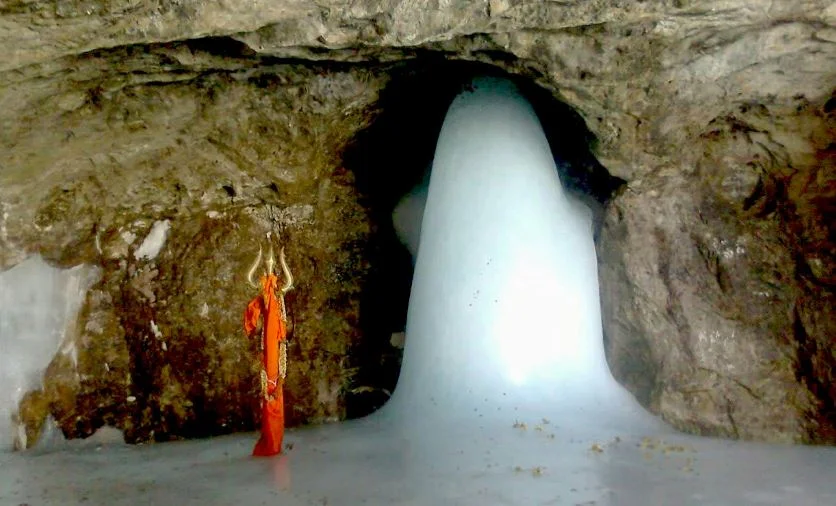
The cave contains a naturally formed ice lingam, which is considered a manifestation of Lord Shiva.
- The ice lingam waxes and wanes with the phases of the moon and reaches its maximum size during the summer pilgrimage.
- Hindus believe that a journey to the Amarnath Cave allows them to seek the blessings of Lord Shiva and attain spiritual enlightenment.
The Amarnath Yatra is considered a sacred pilgrimage that purifies the soul and grants devotees divine blessings.
4. Secret of Immortality
The cave is believed to be the place where Lord Shiva revealed the secret of immortality to his consort, Parvati.
Inside the cave, a stalagmite formation called the “Shivling formed by ice” is worshipped as a representation of Lord Shiva.
It is believed that Lord Shiva resides in the cave and performs the cosmic dance of creation, preservation, and destruction.
5. Opens for a Limited Time Period (2 months only)
The Yatra is open only for a limited period each year due to the extreme weather conditions in the region.
- The Amarnath Yatra typically takes place for a duration of approximately 45 days to 2 months only.
- The pilgrimage begins on the auspicious day of Jyeshtha Purnima and ends on Shravan Purnima.
The Opening and Closing Dates of Amarnath Yatra are determined by the Hindu calendar. The Yatra usually starts in the month of July and concludes in August.
Amarnath Temple Opening/Closing Date 2023
- Shri Amarnath ji Yatra will be 62 days long in 2023.
- Amarnath Yatra Opening date is 1 July 2023 and the Closing date is 31 August 2023.
The timing of the Yatra is carefully planned to coincide with favorable weather conditions.
6. Registration Process of Amarnath Yatra
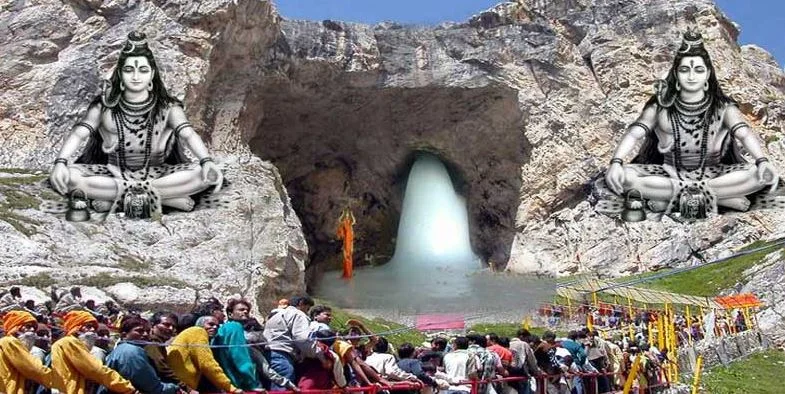
Pilgrims planning to undertake the Amarnath Yatra must register themselves with the Shri Amarnathji Shrine Board (SASB).
The SASB is responsible for managing the Yatra and ensuring the safety and well-being of the pilgrims.
- Registration can be done online or through designated registration centers.
- You can visit Official Website for Amarnath Yatra 2023 Online Registration here – https://www.jksasb.nic.in/
- To undertake the Yatra, pilgrims are required to obtain a Yatra Permit issued by the SASB.
- The number of permits issued each day is limited to manage the flow of pilgrims and maintain safety standards.
7. Amarnath Trek (Trekking to Holy Cave)
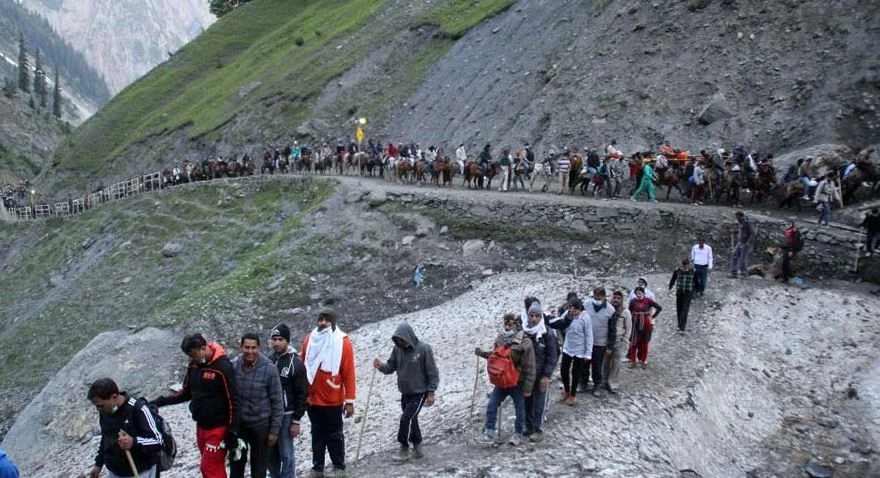
The trekking starts from Pahalgam or Baltal base camp, with treacherous terrains and extreme weather conditions to overcome. The pilgrimage requires physical endurance and determination.
Route 1: Pahalgam Trek
The traditional route to the Amarnath Cave starts from Pahalgam, which is the base camp for the pilgrimage.
- The trek from Pahalgam to the cave covers a distance of approximately 42 kilometers.
- The route passes through breathtaking landscapes, including lush valleys, meandering rivers, and snow-clad mountains.
Route 2: Baltal Trek
The Baltal route, starting from Baltal near Sonamarg, is an alternate route to reach the Amarnath cave.
- This shorter route of Baltal covers a distance of around 14 kilometers. The Baltal trekking route is a shorter but steeper trek.
- Facilities such as tents, medical aid, and refreshment stalls are set up along the trekking route to assist pilgrims.
8. Weather Conditions in Amarnath
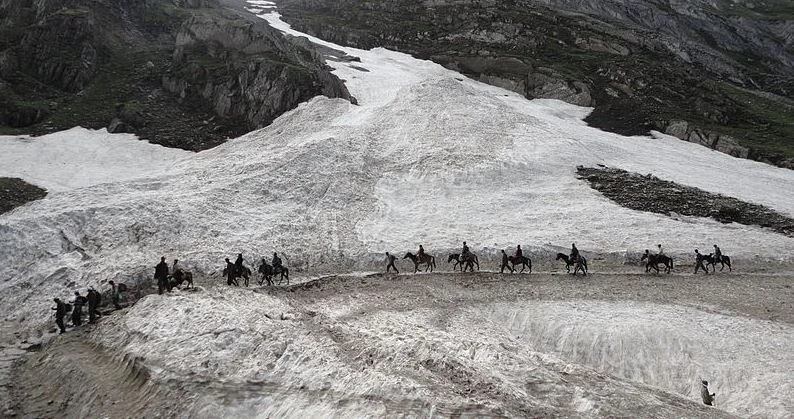
The weather conditions during the Amarnath Yatra can vary significantly.
- The temperature at the Amarnath Cave can drop below freezing, even during the summer months.
- Pilgrims should be prepared to face cold temperatures and carry adequate warm clothing and sleeping bags.
- Heavy rainfall is common in the region, so pilgrims must be equipped with raincoats and waterproof gear.
It is advisable to check weather updates and forecasts before embarking on the Yatra.
9. Pilgrims Count in Amarnath Yatra (Facts and Data)
The number of people who visit the Amarnath Yatra varies from year to year. It depends on various factors such as weather conditions, security situations, and government regulations. In recent years, the annual pilgrimage has seen a significant increase in the number of participants.
How Many People Visit Amarnath Yatra every year? (Last 6 Years)
- In 2016, 2,20,490 people visited Amarnath Cave for darshan.
- In 2017, the number rose to 2,60,003, while in 2018 and 2019, 2,85,006 and 3,43,587 people visited the holy cave of Amarnath.
- In 2019, the yatra was suspended in the run-up to the revocation of special status to Jammu & Kashmir, while in 2020 and 2021, the yatra could not be conducted due to the Covid-19 pandemic.
- In 2022, there are over 3.65 Lakh Yatris participated in the pilgrimage tour to Amarnath.
10. Accommodation in Amarnath
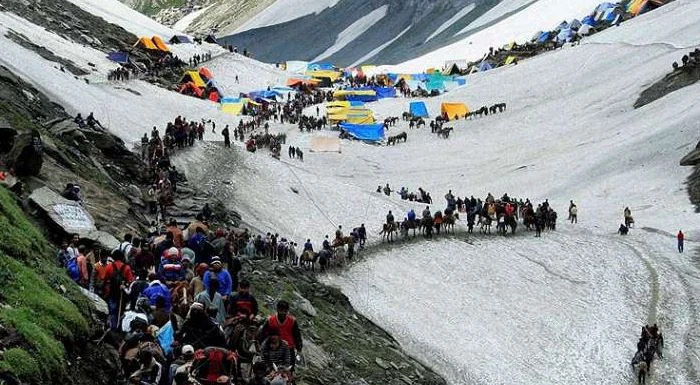
Various accommodation options are available for pilgrims during the Amarnath Yatra.
- At the base camps of Pahalgam and Baltal, there are tents and temporary structures set up to provide shelter to the pilgrims.
- These camps provide basic facilities such as beds, blankets, and common washrooms.
- Some private operators also offer more comfortable accommodation options, including cottages and guesthouses.
It is advisable to book accommodation in advance to ensure availability during the peak pilgrimage season.
11. Medical Facilities at Amarnath
The Shri Amarnathji Shrine Board ensures the provision of medical facilities along the Yatra route.
Medical camps staffed with doctors and paramedics are set up at various points to provide emergency medical aid.
Helicopter services are also available for medical evacuations in case of emergencies.
It is recommended for pilgrims undergo a medical check-up before undertaking the Yatra, especially for individuals with pre-existing health conditions.
Carrying essential medications and a first-aid kit is also advisable.
12. Safety Measures and Security forces
The safety and security of pilgrims are of utmost importance during the Amarnath Yatra. The Yatra route is monitored by security personnel, including the Indian Army and the Jammu and Kashmir Police.
Security checkpoints are set up at various points along the route to ensure the safety of the pilgrims. Pilgrims are required to adhere to the instructions and guidelines provided by the security personnel for their own safety.
It is essential to follow the designated routes and not venture into restricted or dangerous areas.
13. Terrorist Attack on Amarnath Yatra

On July 10, 2017, tragedy struck as a group of Hindu pilgrims were making their way from the Amarnath Temple in the beautiful Kashmir Valley of Jammu and Kashmir, India.
It was the first Monday during the holy month of Shraavana when their journey was abruptly shattered by a horrifying act of terror attack. Sadly, eight innocent pilgrims, primarily from the Indian state of Gujarat, lost their lives in this attack.
The devastating incident claimed the lives of several individuals and left a minimum of 18 others injured, casting a somber shadow over their pilgrimage.
14. Pooja and Rituals Facts about Amarnath Yatra
The Amarnath Yatra involves various rituals and poojas (religious ceremonies) that hold significant importance.
- Poojas are performed at the Amarnath Cave to seek the blessings of Lord Shiva.
- Pilgrims offer prayers, chant religious hymns, and participate in aarti (rituals involving lamps and incense).
The holy water from the cave, known as Amrit, is considered sacred and is believed to have spiritual and healing properties.
Pilgrims often carry back this holy water as a symbol of divine blessings.
15. Age Restrictions and Guidelines
The Amarnath Yatra has certain restrictions and guidelines in place to ensure the smooth conduct of the pilgrimage. It is one of the important facts about Amarnath Yatra.
- The minimum age for participating in the Yatra is usually 13 years, and there is an upper age limit as well.
- Pregnant women, individuals with specific health conditions, and physically challenged individuals are advised not to undertake the Yatra.
- Consumption of alcohol and non-vegetarian food is strictly prohibited during the Yatra.
It is essential to respect the religious sentiments and cultural norms of the region during the pilgrimage.
16. Communal Harmony in Amarnath Yatra
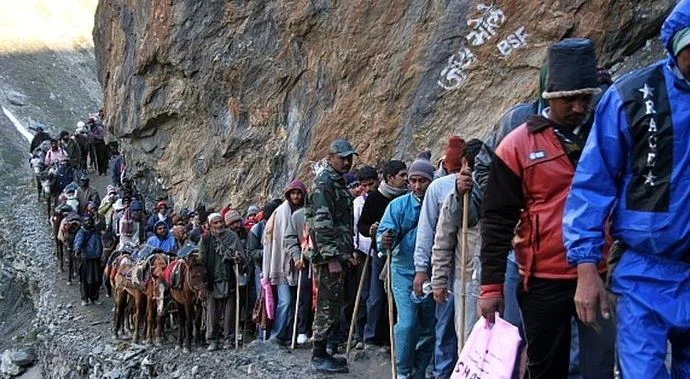
The Amarnath Yatra is not just a pilgrimage but also the best example of communal harmony. It is a journey where people from diverse backgrounds, cultures, and religions come together with a shared devotion to Lord Shiva.
This annual pilgrimage fosters a strong sense of unity and brotherhood among the pilgrims, transcending barriers and promoting mutual respect.
During the Yatra, people from different parts of India, belonging to various faiths, embark on the same arduous journey with a common purpose.
They support and assist each other along the way, showcasing the spirit of camaraderie and solidarity. This unique blend of individuals, hailing from different regions and speaking different languages, creates an atmosphere of inclusivity and harmony.
17. One of the Top Tourist Attractions in J&K
The Amarnath Yatra is undoubtedly one of the top tourist attractions in the region of Jammu and Kashmir.
This sacred pilgrimage to the Amarnath Cave holds immense significance for devotees and travelers alike, attracting a large number of visitors every year.
- The Amarnath Yatra not only offers a spiritual experience but also provides an opportunity to witness the rich cultural and natural heritage of the region.
- The surrounding landscapes are adorned with beautiful meadows, gushing rivers, and snow-capped peaks.
- The stunning natural beauty, coupled with the spiritual aura surrounding the cave, makes it a truly captivating destination.
The Amarnath Yatra holds great economic significance for the region, as it brings in substantial revenue from tourism and pilgrim-related activities.
18. Mystical Spiritual Experiences in Amarnath Yatra
The Amarnath Yatra offers pilgrims an opportunity for spiritual transformation and self-reflection.
Many devotees of lord shiva reported their mystical and spiritual experiences during the Amarnath Cave journey.
- The challenging trek, amidst the serene and awe-inspiring landscapes, allows pilgrims to detach from worldly distractions and focus on their inner journey.
- The ambiance inside the cave, with its divine energy and aura, creates a sense of peace and tranquility. Many pilgrims describe a deep spiritual connection and a heightened sense of devotion during the Yatra.
- The experience of undertaking this sacred journey often leaves a lasting impact on the spiritual outlook of the pilgrims.
Despite the challenges and risks involved, the Amarnath Yatra continues to be a cherished spiritual journey for millions of devotees, fostering a deep connection with Lord Shiva and the Himalayan landscape.
19. Hidden Places to Visit near Amarnath Cave (J&K)
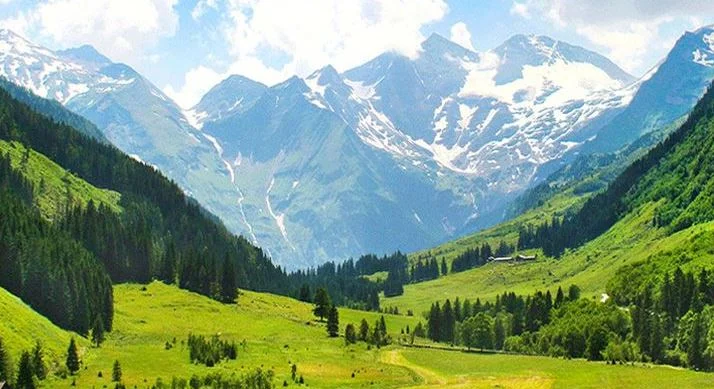
There are several beautiful places to visit near the Amarnath Temple in Jammu and Kashmir, India. Here are some notable destinations:
- Chandanwari
- Betaab Valley
- Aru Valley
- Sonamarg
- Gulmarg
- Srinagar
- Martand Sun Temple
- Achabal Gardens
Chandanwari: Located around 16 kilometers from Pahalgam, Chandanwari is the starting point of the Amarnath Yatra. It is known for its captivating natural beauty, snow-capped mountains, and the glistening Sheshnag Lake.
Betaab Valley: Situated in the Anantnag district, Betaab Valley is named after the Bollywood film “Betaab” which was shot here. It is known for its serene ambiance, meandering rivers, and verdant meadows.
Aru Valley: Located near Pahalgam, Aru Valley is a scenic paradise with lush green meadows, gushing streams, and towering snow-clad peaks. It offers opportunities for camping, hiking, and horse riding.
Sonamarg: Known as the “Meadow of Gold,” Sonamarg is a stunning hill station located in the Ganderbal district. It is famous for its alpine meadows, glaciers, and the enchanting Thajiwas Glacier.
Gulmarg: Located around 150 kilometers from the Amarnath Temple, Gulmarg is a renowned hill station and a popular skiing destination. It boasts beautiful meadows, gondola rides, and panoramic views of the Himalayan peaks.
Srinagar: The capital city of Jammu and Kashmir, Srinagar, is known for its serene Dal Lake, Mughal gardens, and historic landmarks like the Shankaracharya Temple and Hazratbal Shrine.
Martand Sun Temple: Situated in the Anantnag district, the Martand Sun Temple is an ancient Hindu temple dedicated to the Sun god. It is renowned for its architectural grandeur and historical significance.
Achabal Gardens: Located near Anantnag, Achabal Gardens is a Mughal garden known for its terraced lawns, fountains, and picturesque water channel flowing through the garden.
